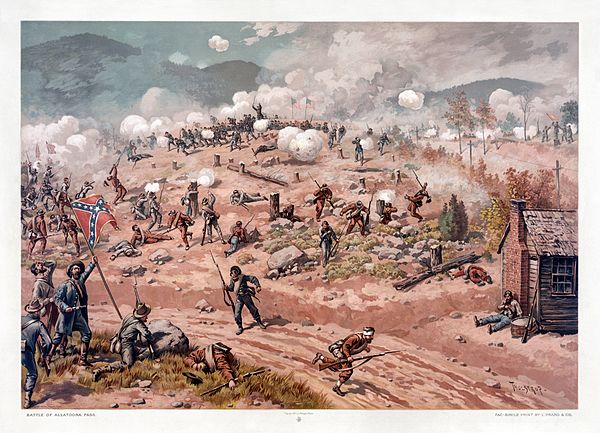

Posted on 10/05/2017 11:21:52 AM PDT by iowamark
The Battle of Allatoona, also known as the Battle of Allatoona Pass, was fought October 5, 1864, in Bartow County, Georgia, as part of the Franklin-Nashville Campaign of the American Civil War. A Confederate division under Maj. Gen. Samuel G. French attacked a Union garrison under Brig. Gen. John M. Corse, but was unable to dislodge it from its fortified position protecting the railroad through Allatoona Pass.
After the fall of Atlanta, Lt. Gen. John Bell Hood moved the Confederate Army of Tennessee northward to threaten the Western and Atlantic Railroad, Maj. Gen. William T. Sherman's supply line...
The Federal troops occupied strong defensive positions in two earthen redoubts on each side of a 180 feet (55 m), 65 feet (20 m) deep railroad cut and many of the men, including most of the 7th Illinois, were armed with Henry repeating rifles...
Gen. Sherman's message to Allatoona via signal flag to "hold the fort" inspired the later popular religious hymn entitled Hold the Fort by Chicago evangelist Philip P. Bliss, which featured the chorus, "'Hold the fort, for I am coming'"
(Excerpt) Read more at en.wikipedia.org ...
""At 8:30, amid a temporary lull of the uproar that had prevailed, a flag of truce was sent in bearing the following message: It was dated
Around Allatoona, Oct. 5, 1864, 7 A. M.
Commanding Officer, U. S. Forces, Allatoona.
Sir:
I have placed the forces under my command in such position that you are surrounded, and to avoid a needless effusion of blood, I call on you to surrender your forces at once and unconditionally. Five minutes will be allowed you to decide. Should you accede to this, you will be treated in the most honorable manner as prisoners of war. I have the honor to be
Very respectfully yours, S. G. FRENCH, Maj.-Gen’l C. S. A.
Reply:
Maj.-General French, C. S. A., etc.:
Your communication demanding surrender of my command, I acknowledge receipt of, and respectfully reply that we are prepared for the ‘needless effusion of blood’ whenever it is agreeable to you.
I am very respectfully your obedient servant, JOHN M. CORSE, Brigadier-General, Commanding U. S. Forces
Corse’s signal dispatch to Sherman after the fight can therefore well be excused, “I am short a cheek-bone and an ear, but able to whip all h—l yet.”""


“Hold the Fort” by Phillip Paul Bliss (1870) was a popular hymn in the late 19th and early 20th centuries. Although flag semaphore, to which the song refers, has largely fallen out of use as a means of military communication, the hymn is still sung in some denominations and can still be found in a number of hymnals.
Sherman would think no more about Hood, and was heard to say, “if he’ll go the
Ohio River, I’ll give him rations.”
https://books.google.com/books?isbn=1440800618
Ho, my comrades, see the signal,
Waving in the sky!
Reinforcements now appearing,
Victory is nigh.
“Hold the fort, for I am coming,”
Jesus signals still;
Wave the answer back to heaven,
By thy grace we will.”
See the mighty host advancing,
Satan leading on,
Mighty men around us falling,
Courage almost gone!
“Hold the fort, for I am coming,”
Jesus signals still;
Wave the answer back to heaven,
By thy grace we will.”
See the glorious banner waving,
Hear the trumpet blow!
In our Leader’s name we’ll triumph,
Over every foe.
“Hold the fort, for I am coming,”
Jesus signals still;
Wave the answer back to heaven,
By thy grace we will.”
Fierce and long the battle rages,
But our help is near,
Onward comes our great Commander,
Cheer, my comrades, cheer.
“Hold the fort, for I am coming,”
Jesus signals still;
Wave the answer back to heaven,
By thy grace we will.”
Thank you for sharing.
Used to sing that song all the time in the church I grew up in.
In a later war this was reduced to simply "Nuts!"


Old Corse School

New Corse School
Thanks for posting!
Right here in beautiful Bartow County!
Disclaimer: Opinions posted on Free Republic are those of the individual posters and do not necessarily represent the opinion of Free Republic or its management. All materials posted herein are protected by copyright law and the exemption for fair use of copyrighted works.